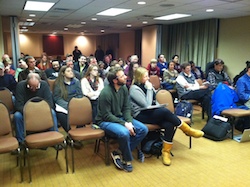The New England Fishery Management Council held the last of 12 public hearings on Draft Omnibus Habitat Amendment 2, including the draft environmental impact statement, in Portland, Maine, on Jan. 7. Ten years in the making, the amendment, designed to address habitat requirements for all of the council's fishery management plans, isn't light reading at 400 pages.
"It's big and it's complicated," council member David Preble told the audience of about 60 people who attended the public hearing on the amendment.
Audience members gathered in Portland, Maine, on Jan. 7 to submit comments at the final public hearing on the Omnibus Essential Fish Habitat Amendment 2 draft. Linc Bedrosian photo"Ten years is too long to create a document," said Jim Odlin, owner of Portland-based Atlantic Trawlers Fishing.
Much attention has been paid to one proposed alternative to open a portion of the Cashes Ledge closed area in the central Gulf of Maine. The proposal could help the region's struggling groundfish harvesters, but the Conservation Law Foundation is fighting to keep the closed area as it is.
Odlin said he supports the idea of modifying closed areas. "The conclusion that larger closed areas are more beneficial is more speculation than anything proven in fact," he said.
Council chairman Terry Stockwell, commenting in his role as the Maine Department of Marine Resources' external affairs director, said the department supports the Cashes Ledge proposal, too, noting that it would allow for a variety of fishing that's important to the region. However, he also cited concerns with other proposed alternatives in the draft.
For example, he said the department opposes the preferred alternative for the Eastern Gulf of Maine, which would prohibit Maine scallopers from fishing in the productive Machias grounds while Canadian scallopers would remain free to do so.
And Patrice McCarron, executive director of the Maine Lobstermen's Association stated that the organization supports the notion of protecting habitat, but opposes the Eastern Gulf of Maine preferred alternative, which could exclude lobster gear.
"Lobster traps don't impact habitat or spawning potential," McCarron said. "The lobster industry is the economic backbone of the Maine coast."
Even though the public hearings are over and the public comment period has ended, there are still opportunities to comment on the plan and proposed alternatives. Comments can be submitted at Habitat Committee meetings and at the council meeting when preferred alternatives are selected. Comments can be submitted either in writing or by attending the sessions in person.
You can click here to read the Amendment 2 public hearing document, and here to read the full Amendment 2 draft.







